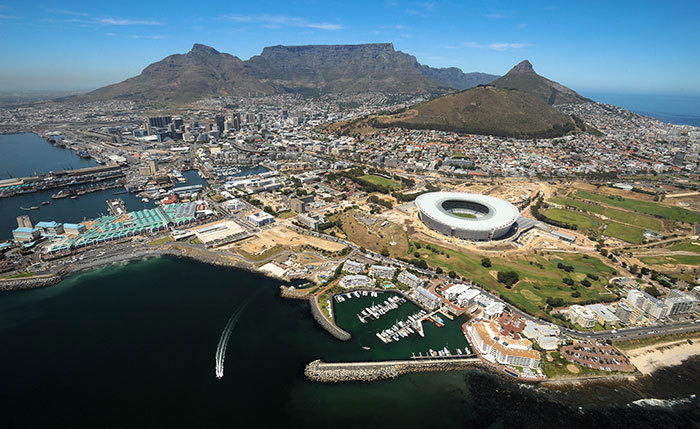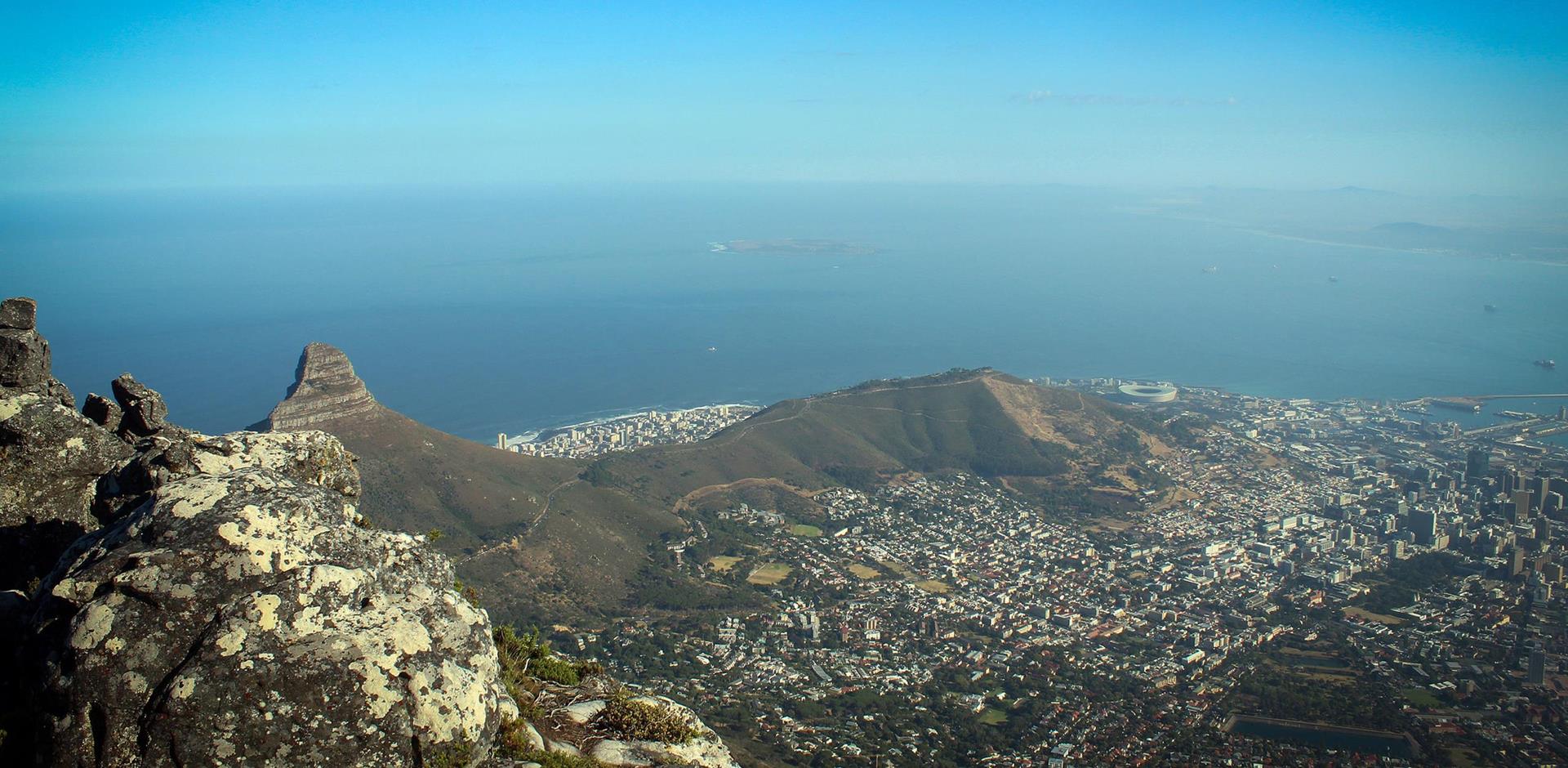Table Mountain (Khoekhoe: Huriǂoaxa, lit. 'sea-emerging'; Afrikaans: Tafelberg) is a flat-topped mountain forming a prominent landmark overlooking the city of Cape Town in South Africa. It is a significant tourist attraction, with many visitors using the cableway or hiking to the top. Table Mountain National Park is the most visited national park in South Africa, attracting 4.2 million people every year for various activities. The mountain has 8,200 plant species, of which around 80% are fynbos, meaning fine bush. It forms part of the Table Mountain National Park, and part of the lands formerly ranged by Khoe-speaking clans, such as the ("High Clan"). It is home to a large array of mostly endemic fauna and flora.
Features
The main feature of Table Mountain is the level plateau approximately three kilometers (2 mi) from side to side, edged by steep cliffs. The plateau, flanked by Devil's Peak to the east and by Lion's Head to the west, forms a dramatic backdrop to Cape Town. This broad sweep of mountainous heights, together with Signal Hill, forms the natural amphitheater of the City Bowl and Table Bay harbor. The highest point on Table Mountain is towards the eastern end of the plateau and is marked by Maclear's Beacon, a stone cairn built in 1865 by Sir Thomas Maclear for a trigonometrical survey. It is 1,086 meters (3,563 ft) above sea level, and about 19 meters (62 ft) higher than the cable station at the western end of the plateau.
The cliffs of the main plateau are split by Platteklip Gorge ("Flat Stone Gorge"), which provides an easy and direct ascent to the summit and was the route taken by António de Saldanha on the first recorded ascent of the mountain in 1503.
The flat top of the mountain is often covered by orographic clouds, formed when a southeasterly wind is directed up the mountain's slopes into colder air, where the moisture condenses to form the so-called "table cloth" of clouds. Legend attributes this phenomenon to a smoking contest between the Devil and a local pirate called Van Hunks. When the tablecloth is seen, it symbolizes the contest.
Table Mountain is at the northern end of a sandstone mountain range that forms the spine of the Cape Peninsula that terminates approximately 50 kilometers (30 mi) to the south at the Cape of Good Hope and Cape Point. Immediately to the south of Table Mountain is a rugged "plateau" at a somewhat lower elevation than the Table Mountain Plateau (at about 1,000 m or 3,300 ft), called the "Back Table". The "Back Table" extends southwards for approximately 6 km to the Constantia Nek-Hout Bay valley. The Atlantic side of the Back Table is known as the Twelve Apostles, which extends from Kloof Nek (the saddle between Table Mountain and Lion's Head) to Hout Bay. The eastern side of this portion of the Peninsula's mountain chain, extending from Devil's Peak, the eastern side of Table Mountain (Erica and Fernwood Buttresses), and the Back Table to Constantia Nek, does not have a single name, as on the western side. It is better known by the names of the conservation areas on its lower slopes: Groote Schuur Estate, Newlands Forest, Kirstenbosch Botanical Gardens, Cecilia Park, and Constantia Nek.

Here are 33 cool facts about Table Mountain:
- It is part of the Table Mountain National Park ( TMNP), a name given to the park in 1998. Prior to that, it was known as the Cape Peninsula National Park;
- TMNP is approximately 25 000 hectares in size;
- TMNP is just one of 21 national parks run by South African National Parks.
- The TMNP is surrounded entirely by a City and is therefore fragmented by urban development and privately-owned land. This, combined with the fact that it is primarily an open-access park with only four managed pay points, has resulted in it being the most visited of all National Parks. A total of 4.2 million people visit it each year;
- The 4.2 million visitors are made up of about 1.5 million people going through pay points. The balance is people using the open access areas of the park for various activities such as hiking, trail running, horse riding, and mountain biking;
- TMNP contains approximately 160km of cycling track. Access is gained via day permits or annual activity permits;
- Table Mountain is one of the New Seven Wonders of the world;
- TMNP is rich in floral biodiversity and is part of the Cape Floral Kingdom World Heritage Site;
- TMNP is home to an amazing 8 200 plant species – of which around 80% are fynbos. The British Isles, three-and-a-half times the size of the TMNP, has less than 1 500 plant species. The most common vegetation type in the TMNP is fynbos (meaning fine bush). Fynbos is fire-dependent vegetation that needs to burn around every 15 years to stimulate new growth and ensure that plant and animal communities remain healthy. However, because of the proximity of houses to the TMNP, fires that would be beneficial to the vegetation are often extinguished. If Fynbos does not burn in about 20 to 30 years it becomes moribund, which can result in the extinction of some species. Many of the plants that occur in the TMNP are endemic – they occur nowhere else on earth. There are 1 406 threatened plant species, 300 of which are endangered or critically endangered, and 29 plant species have already become extinct;
- Table Mountain is featured on Cape Town's flag and on the City's logo;
- Table Mountain got its name because of its flat top;
- The highest point of Table Mountain is 1 086m (3 563 feet) above sea level. It's called Maclear's Beacon after the man who built a stone cairn at the site in 1865. The beacon was built for a trigonometric survey;
- Today there are more than 350 trails to get to the top of Table Mountain;
- The cableway that transports visitors to the top was built in 1929. The capacity of the first cable car was 25 people. Today it can carry 60 visitors to the top;
- Hoerikwaggo – 'Mountain in the Sea' – is the original name given to the mountain chain by the indigenous Khoisan people of the Cape;
- Table Mountain is one of the most popular visitor destinations in Cape Town, and approximately 800 000 people visit it each year;
- The most common animal found on the mountain is the rock hyrax or dassie, a mammal that resembles a guinea pig;
- Table Mountain is thought to be one of the oldest mountains in the world. The rocks of the mountain are approximately 600 million years old. The rocks at the base of the mountain are shale and the rocks at the western side are Cape granite;
- The Cape Point part of the TMNP is rich in cultural and natural heritage and is one of the top tourist destinations in South Africa. Due to the variety of wildlife that occurs there, it is the only section of the TMNP that is fenced, and visitors should look out for Eland, Red Hartebeest, Bontebok, and Zebra;
- At Cape Point, visitors can see the two lighthouses that adorn the southwestern point of Africa. One of these is still fully functional and is accessible by foot or by the Flying Dutchman funicular;
- The Cape of Good Hope section of the TMNP is a haven for outdoor enthusiasts and offers hiking, surfing, angling, picnicking, beaching, and cycling opportunities against the spectacular backdrop of the mountains and coastline of the Cape Peninsula;
- Boulders Penguin Colony in Simonstown is home to a unique and endangered land-based colony of African Penguins. This colony is one of only a few in the world, and the site has become famous and a popular international tourist destination;
- Signal Hill is the northernmost tip of the terrestrial area of the TMNP and offers excellent views of the City and harbor. It is from here that the noonday gun marks midday in Cape Town;
- Table Mountain is 240 million years old, and is one of the oldest mountains in the world (The Alps are a relatively youthful 40 million years old);
- Table Mountain was once three times higher than its eroded remnant form today;
- If it were not for the freshwater supply from Table Mountain's Platteklip stream, Cape Town would have been located at the safer natural harbor of Langebaan on the West Coast;
- The TMNP Marine Protected Area is home to the marine Big Five: the Great White Shark, the Southern Right Whale, the Elephant Seal, the Humpback Whale, and the Minke Whale;
- The TMNP's exceptional marine biodiversity is the result of the mixing of the warm Agulhas and the cold Benguela currents;
- The mountains and the seas of Table Mountain National Park are regarded as the driver of the regional tourist economy and made a cumulative contribution to South Africa's gross domestic product of R 377 million from 1998–2003.
- The Chacma Baboons on the Cape Peninsula forage for shellfish;
- There is a lake in the Cape of Good Hope Section of the TMNP that has no rivers that lead into it: It is kept full only by underground water;
- TMNP has the world's highest concentration of Peregrine Falcons – a cliff roosting aerial predator that kills birds in mid-flight;
- Rhodes Memorial, built in 1912, stands on the slopes of Devil's Peak and within Table Mountian National Park. This National Monument was designed by Sir Herbert Baker as a tribute to Cecil John Rhodes, who at the age of 34 became one of the most powerful mining magnates of all time.
GALLERY





